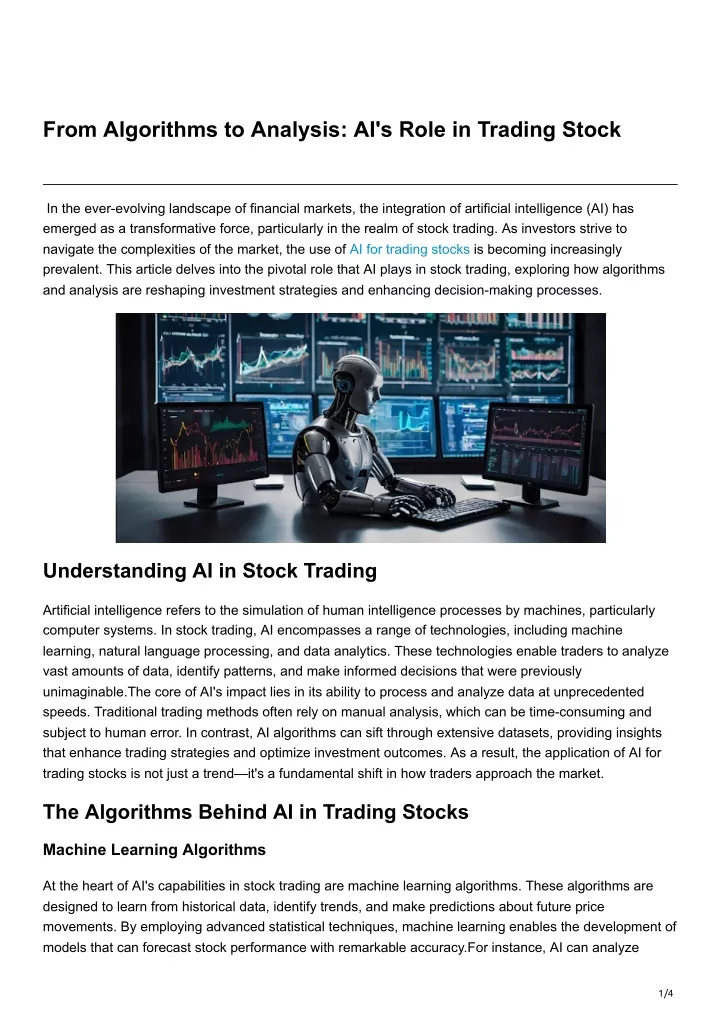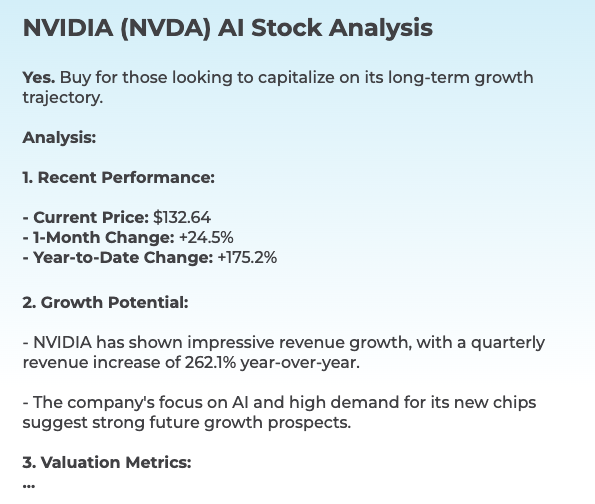20 New Tips On Deciding On AI Stock Predictions Analysis Sites
20 New Tips On Deciding On AI Stock Predictions Analysis Sites
Blog Article
Top 10 Tips For Assessing The Ai And Machine Learning Models In Ai Software For Predicting And Analysing Trading Stocks
The AI and machine (ML) model employed by the stock trading platforms as well as prediction platforms should be evaluated to ensure that the data they offer are reliable, reliable, relevant, and applicable. Models that are poorly designed or hyped up could result in inaccurate forecasts and financial losses. Here are 10 ways to evaluate the AI/ML capabilities of these platforms.
1. Know the Model's purpose and approach
It is crucial to determine the goal. Determine whether the model was designed to allow for long-term investments or trading in the short-term.
Algorithm Transparency: Check if the platform is transparent about what kinds of algorithms are employed (e.g. regression, neural networks for decision trees, reinforcement-learning).
Customizability: Determine if the model can be adapted to your particular strategy of trading or tolerance for risk.
2. Assess the Model Performance Metrics
Accuracy. Find out the model's ability to forecast, but do not depend on it solely because it could be misleading.
Accuracy and recall: Check the accuracy of the model to detect real positives, e.g. correctly predicted price fluctuations.
Risk-adjusted returns: Assess if the model's predictions yield profitable trades following accounting for risk (e.g., Sharpe ratio, Sortino ratio).
3. Test the Model by Backtesting it
Performance history: The model is tested by using data from the past to determine its performance under the previous market conditions.
Tests on data not being used to train: To avoid overfitting, try testing the model with data that was not previously used.
Analysis of scenarios: Check the model's performance under different market conditions (e.g. bull markets, bear markets high volatility).
4. Be sure to check for any overfitting
Signs of overfitting: Search for models that perform exceptionally good on training data but struggle with data that isn't seen.
Regularization methods: Check whether the platform is using techniques like L1/L2 regularization or dropout to avoid overfitting.
Cross-validation (cross-validation): Make sure your platform uses cross-validation to evaluate the model's generalizability.
5. Review Feature Engineering
Check for relevant features.
Feature selection: Ensure the application chooses characteristics that have statistical significance, and avoid redundant or irrelevant data.
Dynamic feature updates: Determine if the model can adapt to changes in market conditions or to new features as time passes.
6. Evaluate Model Explainability
Interpretability - Make sure that the model offers the explanations (e.g. values of SHAP and the importance of features) to support its claims.
Black-box models: Be cautious of applications that utilize extremely complex models (e.g. deep neural networks) without explainability tools.
A user-friendly experience: See whether the platform provides relevant insights for traders in a way that they can comprehend.
7. Assessing the model Adaptability
Market changes: Verify whether the model is able to adapt to changes in market conditions (e.g. new rules, economic shifts, or black swan-related instances).
Examine if your platform is updating the model regularly with new information. This will improve the performance.
Feedback loops. Be sure the model incorporates the feedback from users and actual scenarios to enhance.
8. Check for Bias and fairness
Data bias: Make sure the training data is true to market conditions and is free of biases (e.g. excessive representation of certain sectors or time periods).
Model bias: Verify whether the platform is actively monitoring the biases in the model's prediction and if it mitigates them.
Fairness. Check that your model doesn't unfairly favor certain stocks, industries or trading techniques.
9. Evaluation of the computational efficiency of computation
Speed: Determine whether your model is able to make predictions in real-time or with minimum delay particularly when it comes to high-frequency trading.
Scalability Check the platform's capability to handle large sets of data and multiple users with no performance loss.
Resource usage: Determine whether the model makes use of computational resources effectively.
Review Transparency, Accountability and Other Questions
Model documentation: Ensure that the platform provides comprehensive documentation on the model's structure, its training process as well as its drawbacks.
Third-party audits: Determine whether the model has been independently verified or audited by third-party auditors.
Error handling: Verify whether the platform is equipped to identify and fix model errors or failures.
Bonus Tips
Case studies and user reviews Utilize feedback from users and case studies to assess the performance in real-life situations of the model.
Trial period for free: Try the accuracy and predictability of the model with a demo or free trial.
Support for customers - Make sure that the platform is able to offer a solid support service to solve problems related to model or technical issues.
By following these tips you can examine the AI/ML models on platforms for stock prediction and make sure that they are reliable, transparent, and aligned to your trading goals. Have a look at the best over at this website on investment ai for more examples including ai investing platform, ai for stock predictions, best ai trading app, ai for investment, best ai trading software, ai investment app, best ai stock, ai investing platform, ai investment platform, stock ai and more.
Top 10 Ways To Assess The Social And Community Aspects In Ai Stock Predicting/Analyzing Platforms
Understanding how users share information, interact and learn is crucial to understanding the AI-driven trading and platform for stock predictions. These features can enhance the user's experience as well as provide useful help. Here are 10 top strategies for evaluating the social and community aspects of these platforms.
1. Active User Group
Tip: Look for an online platform with a large user base who frequently participates in discussions, offers insights and feedback.
Why: An active user community represents a lively community where users can learn from each other and grow together.
2. Discussion Forums & Boards
Tips: Take a look at the level of engagement and quality on discussion forums or a message board.
Forums enable users to ask questions, share strategies, and discuss the latest market trends.
3. Social Media Integration
Tips - Make sure that the platform can be integrated with social media sites (e.g. Twitter and LinkedIn) to provide information and updates.
Why: Social media integration can enhance engagement and provide current market updates in real-time.
4. User-Generated Content
Tips: Search for options that let users make and distribute content, such as articles, blogs, or trading strategies.
Why: User-generated content creates an environment of collaboration and offers different perspectives.
5. Expert Contributions
TIP: Find out if the platform features contributions from industry experts, such as market analysts, or AI specialists.
The reason: Expert insights add credibility and depth to discussions within communities.
6. Real-Time Messaging, Chat and Chat in Real Time
TIP: Find out if users can communicate with one another instantly using real-time chat or messaging.
The reason: Real time interaction allows quick information sharing and collaboration.
7. Community Moderation and Support
TIP: Check the level of support and moderation within the community (e.g., moderators, customer service representatives).
Why: Effective moderating ensures that a friendly and welcoming atmosphere is maintained, while customer support helps resolve issues quickly.
8. Webinars and events
Tip Check whether the platform offers live Q&A hosted by experts, or webinars.
What's the reason? These events are a good opportunity to learn about the field and to have direct contact with professionals.
9. User Reviews and Feedback
Find options that give users to submit reviews and feedback on the platform or the community functions it offers.
Why: User feedback is used to determine strengths and areas for improvement in the community environment.
10. Gamification of Rewards
Tips: Determine if the platform incorporates games elements (e.g., leaderboards, badges) or rewards for active participation.
Gamification is a way to encourage community members to become more active.
Bonus Tips on Security and Privacy
Make sure you use strong security measures and privacy protections when using the social and community features. This will protect your personal information and data.
When you look at these aspects and analyzing these variables, you can determine if an AI-based stock prediction and trading system provides a supportive community that will enhance the experience of trading. Follow the most popular free ai stock picker for website tips including ai options, ai copyright signals, investing with ai, best stock prediction website, ai share trading, ai share trading, trading ai tool, how to use ai for stock trading, best ai stocks to buy now, ai software stocks and more.